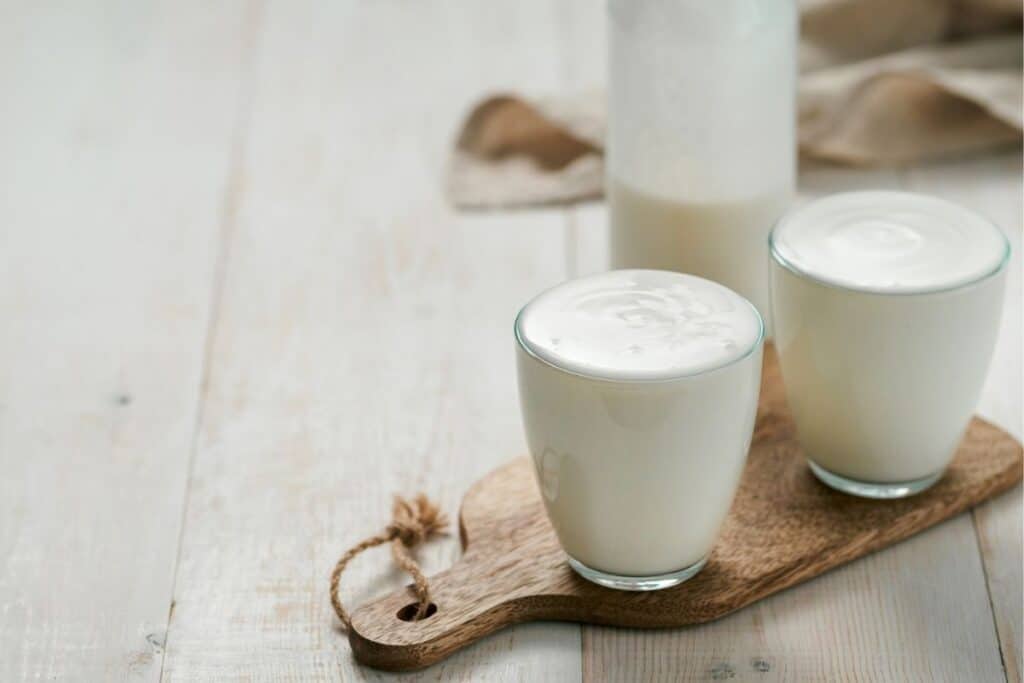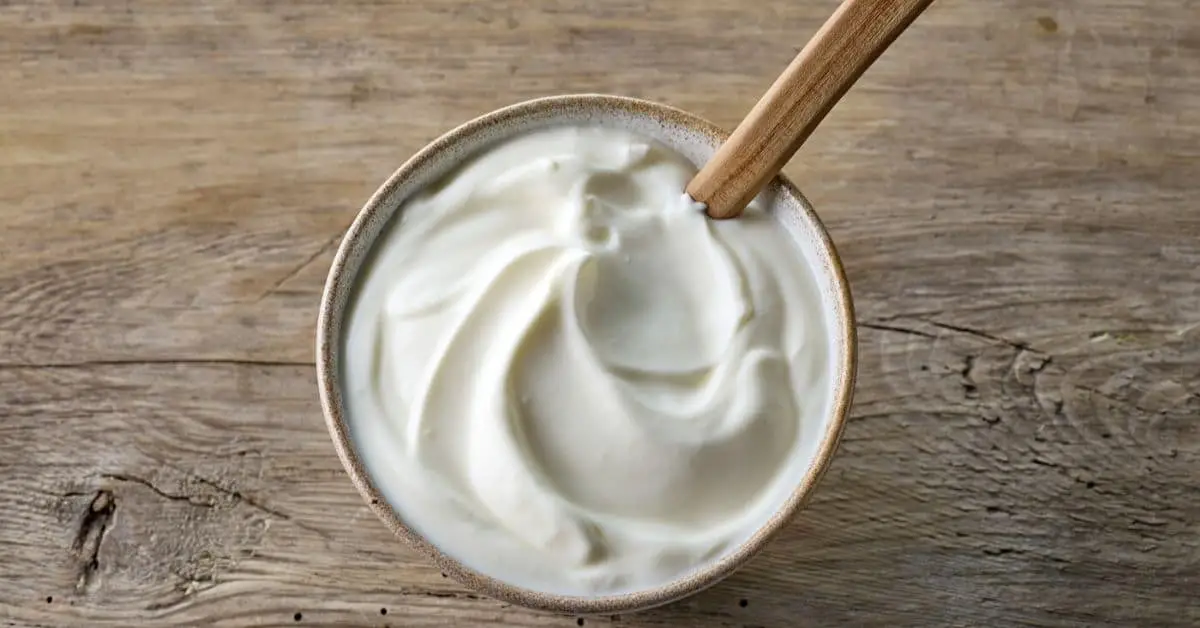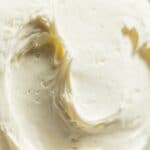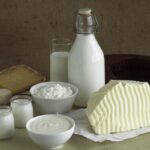In summary: Buttermilk can be substituted with regular milk with vinegar or lemon juice, sour cream, plain yogurt, kefir, reconstituted buttermilk powder, etc. We also explain the benefits of using buttermilk and how to use each substitute in different recipes below.
If you have a last-minute craving for freshly baked biscuits or deliciously battered, deep-fried chicken, but don’t have any buttermilk on hand, don’t stop cooking. Buttermilk is one ingredient that you can easily substitute with other staples you likely already have around.
Even if you are lactose intolerant, there’s a suitable buttermilk substitute for you. The replacement you choose may depend not only on what you have in the pantry but also on the specific dish you are making.
In this guide, we’ll help you whip up something craveable in a flash with the best substitutes for buttermilk in sweet or savory applications.
What is Buttermilk?
Is it butter or is it milk? The name is a little confusing but traditional buttermilk was derived as a by-product from churning cultured cream to make butter. This method isn’t really used anymore, and buttermilk nowadays is produced by means of milk fermentation or as a cultured dairy product. This essentially produces a type of sour milk with a tangy taste and thicker consistency than fresh milk.
The dairy component brings creaminess to the recipe while the acid component in the buttermilk reacts with raising agents in batters or dough to create airy baked goods. It is also beneficial in retaining moisture in meaty and fried dishes, tenderizing meat, and enhancing the added flavors in meat recipes.
From sourdough, bread, scones, biscuits, waffles, pancakes, banana bread, and cakes to deep-fried chicken, marinated lamb, and batter-fried items, buttermilk is versatile and improves the quality of many dishes.
It is generally sold in 32 fl oz containers at grocery stores which is probably a lot more than you’ll need for just home cooking. If you don’t want to buy such a large quantity for just the one cup your recipe calls for, choose one of the below alternatives to get the same result without letting any ingredients go to waste.
Best Dairy Replacement for Buttermilk
Milk and Distilled White Vinegar
You can use regular dairy milk as a substitute for buttermilk with a small amount of vinegar to add the acid component. If you want to duplicate the recipe exactly, use the type of milk (full cream or low fat) that the recipe calls for. However, if you are watching your calorie intake, you can always go for a fat-free version or tailor the recipe to your dietary needs by using lactose-free milk.
The best vinegar to use is distilled white vinegar since it has a neutral taste that won’t affect the flavor profile of the dish. If you don’t have any white vinegar, you can also use apple cider vinegar, just keep in mind that it has a different fruity undertone. Since such a small amount of vinegar is used, it shouldn’t make a significant difference in the flavor.
For this buttermilk substitute recipe, to make 1 cup, place 1 tablespoon of white vinegar into your measuring jug and then fill the jug to the 1 cup line with milk. Stir to mix the liquid and let the mixture sit for three to five minutes. It will start to thicken or curdle, which is what you want since you’re souring the milk.
See more: Whole milk replacement
Milk and Lemon Juice
Milk and lemon juice work in the same way as milk and vinegar where lemon juice provides the acid component. As with the above example, you can use low fat, lactose-free, or whole milk as per the recipe or your dietary requirements.
To replace one cup of buttermilk, use 15ml lemon juice (one tablespoon) mixed with one cup of milk.
Fresh lemon juice is best since it does not contain any preservatives. If you use bottled lemon juice, be aware that it may contain sodium benzoate and sodium sulfite as preservatives which trigger allergies in some people.
Milk and Cream of Tartar (or Baking Soda)
Cream of tartar is another ingredient that can be used as an acid component when combined with milk for a suitable substitution for buttermilk. Cream of tartar is generally used in baking as a raising agent and is interestingly a by-product of wine production. The fine white powder has a neutral taste so it won’t affect the flavor profile of your dish.
To prevent cream of tartar from forming lumps when mixed with the liquid, combine 5 grams (1 ¾ teaspoon) of the powder with just a few drops of milk to form a smooth paste and then stir it into one cup of milk.
Alternatively, you could also sift the same amount of cream of tartar with the other dry ingredients and then add one cup of milk. The danger here, however, is that you do not mix the cream of tartar thoroughly throughout the dough.
Baking soda can be used if you do not have cream of tartar on hand.
Related: What can I use in place of cream of tartar?
Sour Cream
If you have any sour cream in the refrigerator that needs to be used, this will make a good substitute since sour cream is like a thicker version of buttermilk. Lactic acid bacteria is used to ferment cream which gives it a similar tangy taste.
Since sour cream is thicker, you’ll need to dilute it to prevent your batter’s consistency from being too thick. You can use either water or milk to dilute it. To substitute buttermilk and make one cup, use ¾ cup sour cream mixed with ¼ cup water.
Plain Yogurt
Plain, unflavored or Greek yogurt that has a similar tangy flavor is an easy buttermilk substitute. The type of yogurt you use will determine how much you need to dilute it since full cream yogurt is generally much thicker than fat-free versions.
As a substitute for one cup, use ¾ cup yogurt mixed with ¼ cup water or milk. If the yogurt is very thick, use ⅔ cup yogurt and ⅓ cup water to get the right consistency. Whisk the water and yogurt together to create an even, smooth texture before adding it to the dry ingredients.
Kefir
Kefir is a tangy fermented milk that has the consistency of drinking yogurt. It is known for its beneficial properties, especially for gut health, however, when heated most of these useful microbes are killed. Unflavored or plain kefir can be used as a substitute in equal quantities.
Reconstituted Buttermilk Powder
Like milk powder, buttermilk powder lasts much longer than the fresh version. This makes it possible to have it on hand whenever needed without worrying about it going off.
There are two ways you can use buttermilk powder as a substitute for the fresh fermented dairy. Firstly, you can reconstitute it with water as per the package instructions and replace the reconstituted liquid directly for the real thing.
Alternatively, sift the buttermilk powder with the other dry ingredients and then add water to the dry ingredients where you would otherwise have added buttermilk. This works best for batters such as cakes, pancakes, and waffles.
The general reconstituting ratio for one cup buttermilk is 1 cup of water mixed with ¼ cup of powder.
Dairy-Free Buttermilk Alternative
To make your vegan buttermilk substitutes equal to one cup, use a liquid measuring cup and measure 1 cup of any of the below non-dairy milk alternatives. Add your acid component being either 1 tablespoon lemon juice/vinegar OR 5 grams (1 ¾ teaspoon) cream of tartar.
Soy milk
This popular alternative to dairy is made by soaking and blending soybeans. The milky liquid is then strained and filtered. You get flavored, plain unsweetened, and sweetened versions. Choose plain unsweetened soy milk as your replacement. As with dairy alternatives, you have to add an acidic component to the liquid which can be in the form of lemon juice, vinegar, or cream of tartar.
Some soy brands have a more assertive taste than others which could slightly affect the flavor of your batter. If you are using a sweetened version, reduce the amount of sugar you add to the recipe elsewhere by approximately two tablespoons to prevent it from being overly sweet.
Since this is a soy-based product it is not suitable for people with soy allergies.
Rice or Oat Milk
These two grain-derived milk types are a suitable substitute if you cannot have soy. They generally come unflavored but may be sweetened or unsweetened. Choose unsweetened options as far as possible.
Both rice and oat milk have a very neutral flavor, so they won’t affect the flavor of your dish. Unsweetened rice milk is generally lower in calories than other alternatives but it’s not a very creamy product. If a rich creaminess is an important factor in the dough or batter, opt for something a little more luxurious.
Vegan Yogurt
Vegan yogurt can be used in the same way as dairy yogurt for a substitute. Opt for an unflavored vegan yogurt that is not sweet and dilute it with water until you get the desired consistency. Once diluted, replace it cup for cup. As a rough guideline, ¼ cup water blended with ¾ cup yogurt will generally give you a suitable consistency. Vegan yogurts can be made from soy or coconut, so check the label for allergies.
Tofu
This may come as a surprise, but if you have some soft tofu in the fridge that needs to be eaten, you can easily repurpose it into a suitable substitute. We assume you probably won’t have tofu in the fridge if you have a soy allergy. However, just remember, if you are cooking for someone with an allergy this won’t be a good choice. A softer type of tofu is best as it will blend and break down easily.
To make your substitute for one cup, place ¼ cup (62g) plain silken tofu into a blender. Add 160ml (¾ cup) of water and 1 tablespoon of lemon juice or vinegar. Distilled white vinegar is best but if you only have apple cider vinegar that will do. Blend together to form a thin drinking yogurt type of consistency. Use this as a substitute for buttermilk in baking recipes, pancakes, or waffles. For marinades, we suggest a different alternative.
Coconut Milk
The cloudy white liquid extracted from ripe coconut flesh is called coconut milk. People often confuse coconut cream and coconut milk. Coconut cream is also derived from coconuts but has a much higher fat content, is much creamier and denser.
One thing to keep in mind when you use a coconut product as a replacement is that it will most likely have an effect on the flavor of your dish. Coconut milk is recommended, but if you only have coconut cream you can use it as well or dilute it as a substitute. Don’t forget to add your acid component of 15ml vinegar or lemon juice per cup of liquid.
This substitute is suitable for people with gluten, dairy, or soy allergies, is vegan, and paleo-friendly.
See more: Substitute for coconut cream
Unsweetened Almond Milk
This is another low carb, paleo friendly, gluten- and soy-free alternative. Like other vegan alternatives, this comes in unsweetened, sweetened, plain, or flavored varieties. For the best results use a plain, unsweetened version of almond or another nut milk.
Nut milk is made by soaking and blending the nuts and then straining out the fibers. They have a lovely rich and light nutty taste that complements most flavor profiles.
Add the acid and replace it in equal measures.
FAQ
Conclusion
Buttermilk is an underrated and extremely versatile ingredient for sweet and savory cooking and baking, marinades, frying batters, and more. It is easy to substitute with a dairy free version or something that better suits your dietary needs.
Substitutes like yogurt and dairy-based alternatives are good for all applications from batters and marinades to pancakes, soda bread, waffles, cakes, and biscuits. Some vegan options can influence the taste of your dish slightly, however, most of them are suitable for any baking and dessert recipes, waffles, and pancakes.
If you have milk in the fridge that is one or two days past its expiry and has just started to go sour, you can use it as a buttermilk replacement in baking recipes. You won’t even know the difference.
Up next:
*image by PantherMediaSeller/depositphotos









